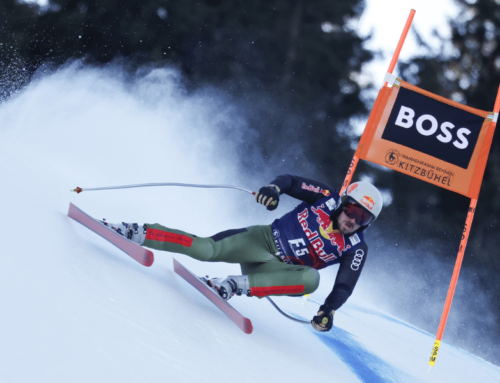Is live timing good for parents (and racers)?
This article is my third and final column in a series on the role of technology in ski racing (here’s #1 and #2). Today, I will focus on one particular recent technology that is changing the way we follow races. I’m talking about live timing that now “essential” tool for the ski racing world to track race results in real time.
Let me preface my comments by saying that I have nothing personally against live timing. I actually use it to follow the racers I work with. I also realize that there are many benefits of live timing to many in the ski racing community including officials, coaches, parents, the media, and racers themselves. At the same time, like every form of technology, there are unintended, and not necessarily healthy, consequences that I would like to point out in this article so that everyone who uses Live Timing can be sure to maximize its value and minimize its liabilities.
Let me share with you some examples of less-than-positive use of live timing before I discuss specific concerns I have:
- Parents at races watching live timing on their smartphones rather than watching their kids race.
- Parent’s knee-jerk reactions in the finish line or remotely to their children’s race results, whether extreme excitement or stunning disappointment, immediately after their kids finish.
- Parents who aren’t at the race calling their spouse at the finish line and the spouse handing their phone to their kid even before they have time to catch their breath.
- Parents who are not at the race and make assumptions (usually inaccurate and negative ones) and pass judgment (ditto) about how their child did before getting the full story.
Behind these overt and fairly egregious uses of live timing are some pretty significant messages that you communicate to your young racers when you use the tool inappropriately or excessively.

Photo: Agence Zoom
The first message that your kids may get from a preoccupation with live timing is that results are what matter most to you. It’s easy to say that your children’s ski racing is about having fun, being challenged, and developing important life skills, but let’s be realistic: results matter. But, as I have written about previously, your children are more likely to get the results that they and you want if they focus more on the process than the results. Your children already get unhealthy messages from our hyper-intense achievement culture, their schools, their peers, and, often, their coaches. The fewer messages about results they get from you, the better. Yet, when you are all over live timing, rather than focusing on your kids’ experience and performance in the race, you are sending the unhealthy message that results are the priority.
The second message that your children may get involves how important their ski racing is to you. Of course, you are going to care about your kids’ ski racing. Otherwise, why would you devote so much time, energy, and money into our sport? But, this investment can turn into over-investment of your self-esteem and ego in which their results become your ROI (Return on Investment). When your children see you using and talking about live timing too much, you’re communicating to them that their ski racing is really important to you, which places the weight of expectation on their shoulders. That burden can lead to fear of failure, pressure, and competitive anxiety, all of which will prevent your kids from getting the results they and you want. It also sucks the fun and enjoyment out of their participation in our sport.
Following live timing rather than your children’s actual race day experiences can color your initial reactions to their race performances. If you’re paying more attention to their time on live timing than how they are skiing, you might miss how good their skiing is or the mistake they made that resulted in a slow time despite really good skiing. You allow your judgments to be formed based on a time rather than on the gestalt of their racing experience. When you focus on their time, you may miss out on their excitement, determination, and resilience in facing what we all know to be a very difficult challenge every time they ski from the starting gate to the finish line. A race run, whether fast or slow, flawless or mistake ridden, cannot be summed up in a time you see on a screen.
Live timing can also become another manifestation of the (creepy) “tracking your kid” culture in which you are following them constantly without their awareness of it. This obsession, which is exploding in popularity among parents, has several problems, in my view. It suggests that you don’t trust your children to be safe and make good decisions (admittedly, not an entirely inappropriate reaction for some kids). Second, it sends them the message that they are tethered to you and you won’t let go.
Also, by engaging with them indirectly (called “mediated experience” in tech-psych speak), you are missing out on engaging with them directly. With a screen between the two of you, you as a parent are going to be missing the stuff of which young lives are about, namely, challenge, pushing limits, and the satisfaction of a great effort. You will also miss out on what a deep parent-child relationship is based on, namely, real connection (in the old-school sense of the word), emotions, physical contact, and all of the subtle information you garner from your children when you share their experiences directly and miss when you have a screen between the two of you.
Finally, one of the most important aspects of ski racing in children’s development is their experiences after their races, success or failure. The time after they cross the finish (or don’t) is when they learn their greatest lessons from our sport, for example, overcoming disappointment, staying motivated and positive in the face of mistakes and adversity, and learning to reconcile their aspirations with their performances. When you track them with live timing or intrude on this time by asking them to talk to their non-present parent on your smartphone, you deprive them of the valuable time they need to process their performance and experience its emotional impact.
I’m not saying that you should swear off live timing completely. As most forms of technology, it’s not whether you use it, but rather how, when, and why use it. Here are some suggestions for you to use live timing as a tool to support your children’s racing efforts rather than as a weapon against them:
- If you’re at races, keep your smartphone, and live timing, in your pocket. Allow yourself to fully experience your child’s race directly rather than through a screen. Then, connect with your child after the race in the most caring way possible. Finally, when they’re hanging out with their friends and have put the race behind them, you can sneak into a corner of the lodge, pull out your phone, open live timing, and do a detailed analysis of his or her times and result (or, better yet, hang out with other parents and have fun yourself).
- If you’re not at the race, don’t track your child’s race second by second and interval by interval; the inevitable emotional roller coaster doesn’t feel good. Instead, get a full report from your child after the race (when they’re ready to engage with you) before you look at live timing and make the inescapable judgments and comparisons with his or her peers (or, better yet, just bask in the reflected experiences they are having and be grateful you have the opportunity to share those experiences with your children).
Look, I’m a realist and recognize two things related to live timing. First, that I’m going to get some blowback from parents who just don’t agree with my stance on live timing and feel that it’s a perfectly fine way to follow their children’s racing and stay connected with them. And I’m certainly open to being shown what I’ve missed. Second, that most parents aren’t going to be able to resist the siren’s call of live timing when their children are racing. But if I can get just a few parents to set their media aside on race day and really be in the moment with their children, then I’ll feel that I’ve done my job.





















